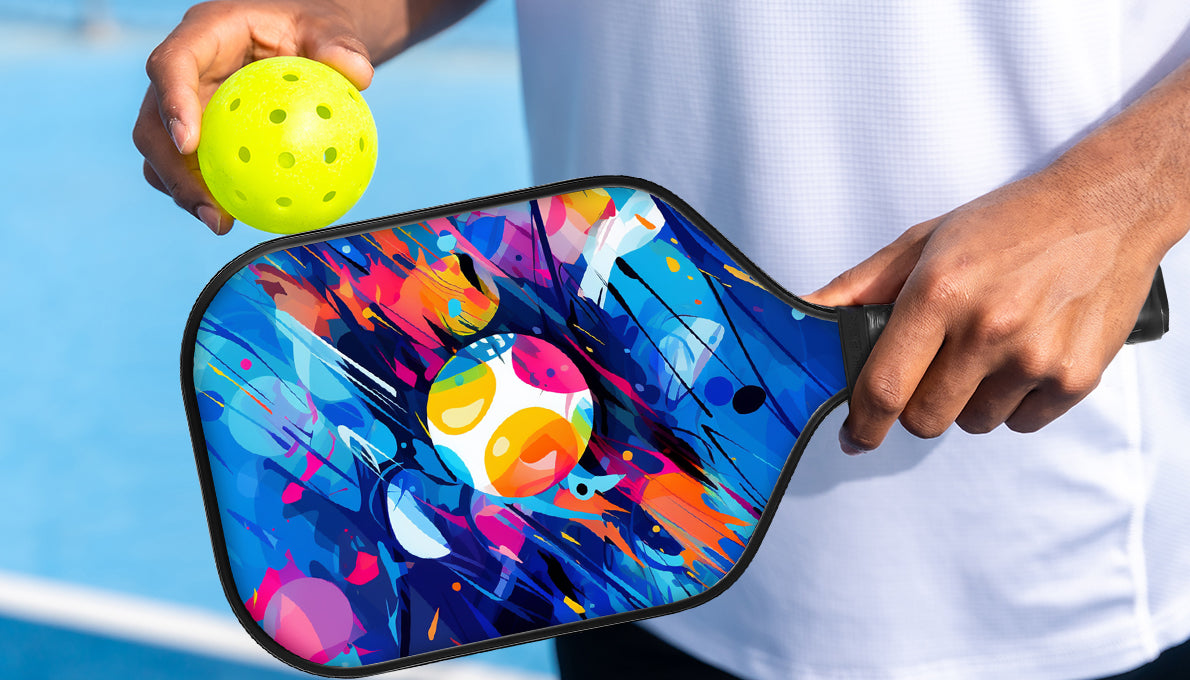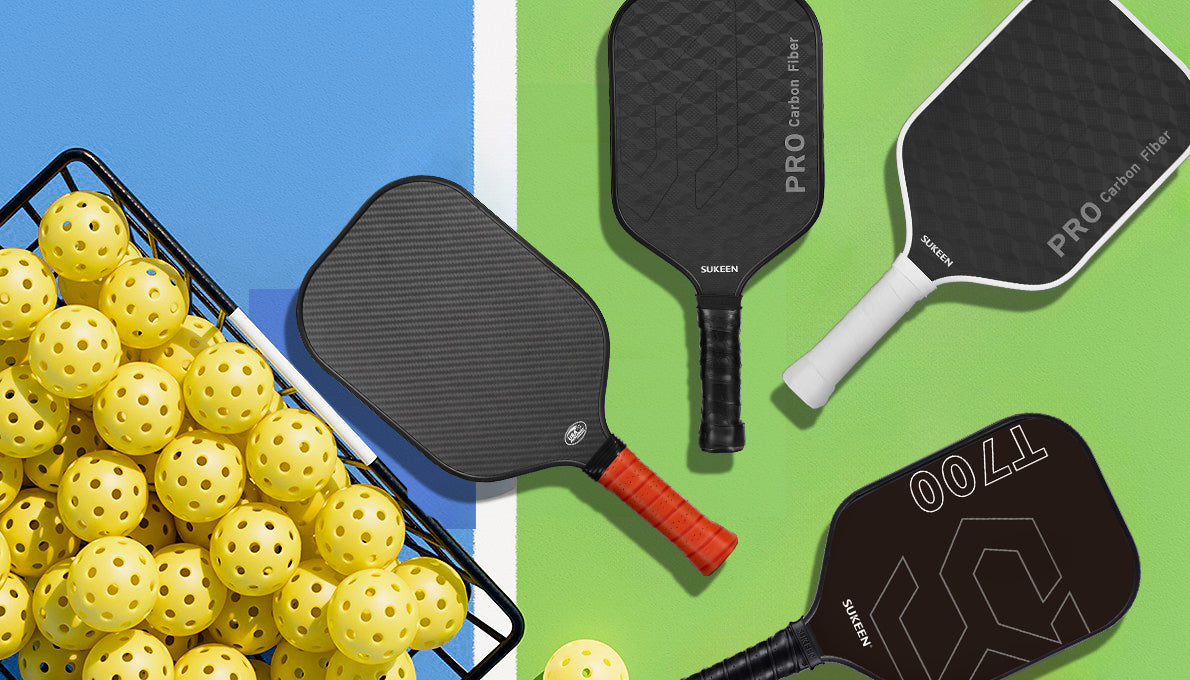What is a Dead Spot in a Pickleball Paddle?
Ⅰ. What is a Dead Spot?
Ⅱ. Why do Dead Spots Occur?
Ⅲ. How to Detect Dead Spots?
Ⅳ. The Impact of Dead Spots on the Game
Ⅴ. How to Avoid and Repair the Dead Spot
Ⅵ. Notes after Repair
Ⅰ. What is a Dead Spot?
Dead spots are areas on the surface of a pickleball paddle that do not produce the ideal rebound effect when striking the ball, resulting in decreased ball speed and reduced control. These areas typically form due to material aging, manufacturing defects, or wear over time. The presence of dead spots significantly impacts shot power and accuracy, thereby affecting overall game performance. While the normal areas of the paddle deliver a crisp and powerful touch, the dead spot areas feel dull and weak.For an article on finding the sweet spot, you can refer to the "Pickleball Paddle Sweet Spot Guide".
Ⅱ. Why do Dead Spots Occur?
1. Material aging
With prolonged use, the material of the paddle will gradually deteriorate. Whether it is carbon fiber, fiberglass, or other composite materials, they will lose their original elasticity and strength over time. This aging process is especially accelerated for paddles that are used frequently, leading to decreased rebound performance in certain areas, thereby forming dead spots.Players who use their rackets for training or competition every day may start to feel a decline in performance within a few months.Although it will age, we can choose high-quality materials that are not prone to aging and can be used for a longer period of time. You can refer to "What is the best material for a pickleball paddle?".
2. Manufacturing defects
Defects in workmanship or the quality of materials during the paddle's manufacturing process can result in some areas performing less effectively than others. Defects such as uneven lamination, inconsistent glue application, or loose carbon fiber or fiberglass weaving can negatively affect the paddle's performance and create potential dead spots. The lamination process involves combining multiple layers of material under high temperature and pressure to boost the paddle's strength and elasticity. However, if the lamination is uneven, it can lead to irregular material distribution in certain areas, forming localized weak points.These weak points cannot absorb and rebound the force of the shot as effectively as other areas, forming potential dead spots.
3. Long-term use and wear and tear
Even high-quality rackets will wear and tear during long-term use. Each shot will cause micro-damage to the racket. As the number of uses increases, these micro-damages will gradually accumulate and concentrate in certain areas, eventually causing these areas to lose elasticity and form dead spots.
4. Improper use
Improper use can also accelerate the aging and wear of the racket, leading to dead spots. For instance, consistently hitting the ball with a specific area of the racket will cause that area to wear out faster than others, eventually forming a dead spot. Additionally, many pickleball players often use their racket to scoop or pick up the ball to save effort. This method, although seemingly convenient, can cause potential damage to the racket, particularly to the bottom and edges. Wear and tear in these areas can lead to a deterioration in material properties, preventing effective energy transmission during ball contact. This weakens the structural strength of these areas, potentially creating dead spots.
Frequent friction and collisions accelerate material fatigue, causing the racket to lose its original elasticity and toughness, making dead spots more prominent. If you don't want to bend down to pick up the ball while playing pickleball, you can use a ball picker. I have been using SUKEEN's ball picker. It is very convenient to pick up the ball and the ball picker has a large storage capacity, which can hold many pickleball balls.
5. Physical damage
During use, the racket may accidentally sustain physical damage from collisions or falls. These incidents can damage the racket's internal structure, particularly breaking the carbon fiber or fiberglass layers. As a result, certain areas may lose their elasticity and strength, leading to the formation of dead spots.The advantages of using a pickleball paddle with an edge guard design are highlighted here. You can read "A Guide to Pickleball Paddle Edge Guard Types" to learn more.
Ⅲ. How to Detect Dead Spots?
Detecting dead spots is an important step to ensure the performance of the racket. Here are some methods and tips to help players detect dead spots on rackets.
1. Auditory test method
a). Tap the surface of the paddle
Tap the surface of the racket gently with your fingers or a ball, and listen to the changes in the sound. Usually, a healthy racket will make a crisp and consistent sound. If a certain area makes a dull or uneven sound, this may be a sign of a dead spot.
b). Rack resonance
Hold the handle of the racket and gently tap different parts of the racket, paying attention to the resonance feeling. If the resonance in a certain area is significantly reduced, this may also be the location of the dead spot.
2. Visual Inspection Method
a). Surface Wear and Cracks
Carefully inspect the surface of the racket for obvious wear, cracks, or other damage. These physical damages are often the cause of dead spots.
b). Material Discoloration
Check the surface of the racket for color changes or uneven areas. Discoloration can be a sign of aging or damage to the material, and may also be related to dead spots.
3. Feel Test Method
a). Hit Feel
In actual use, players can determine whether the racket has a dead spot by the feel of the ball when hitting the ball. If a certain area feels weak when hitting the ball, the rebound effect is poor, or the ball control is reduced, this may indicate that there is a dead spot in that area.
b). Grip Feel
Grip the racket with different strengths and angles and pay attention to the changes in the feel. If an area feels significantly different or has abnormal vibrations, this may also be a sign of a dead spot.
4. Tactile Test Method
a). Lightly Press the Surface
Press the surface of the racket lightly with your fingers to feel for soft spots or uneven areas. Soft spots are often the result of material fatigue or delamination and are potential locations for dead spots.
b). Surface flatness
Gently stroke the surface of the racket with your palm to feel for any uneven areas. A flat surface usually rebounds better, while an uneven area may be a dead spot.
5. Professional equipment detection method
a). Vibration analyzer
The vibration analyzer can accurately measure the vibration frequency and resonance characteristics of different areas of the racket to help identify the dead spot area. This method usually requires professional equipment and technical support, but can provide very accurate detection results.
b). Thermal imager
The temperature distribution on the surface of the racket is detected by a thermal imager. Areas with different material densities will have different temperature changes after heating. The dead spot area may show abnormal temperature distribution.In addition to the material and specifications of a good racket, the manufacturing process is also something we should consider. If you are interested in the thermoforming process, you can read "The Secret of the Thermoformed Pickleball Paddle".
Ⅳ. The Impact of Dead Spots on the Game
1. Reduced hitting power
When there is a dead spot on the racket, the hitting power will be significantly reduced. The rebound effect of the dead spot area is poor, and the racket cannot effectively transfer the kinetic energy of the ball back to the ball, which means that more power is required to achieve the same effect each time the ball is hit. During the counterattack, you feel a dull feedback when the racket hits the ball, and the ball flies shorter than expected. For players, this not only increases physical exertion, but may also cause fatigue in the arms and shoulders.
2. Reduced control of the shot
The dead spot reduces the control of the racket's shot, making it difficult for players to accurately control the direction and strength of the ball. In a game, accurate shots are essential to winning. The instability of the dead spot area makes the direction and strength of the ball's rebound unpredictable when it hits, increasing the possibility of errors. You try to hit the ball into the gap in the opponent's court to score. However, due to the dead spot on the racket, your shot deviates from the intended direction and falls directly on the opponent's racket face, which directly has a huge impact on the outcome of the game.
3. Increased error rate
The dead spot significantly increases the player's error rate. In a game, any error may change the trend of the game. The existence of the dead spot area makes the result of each shot unpredictable, increasing the risk of errors. This also has a negative impact on the player's psychological state, making him more nervous and uneasy during the game.
4. Impact on psychological state
The dead spot on the racket affects the psychological state of the player. When the player cannot rely on the performance of the racket, he will feel uneasy and anxious. This psychological pressure will further affect the performance of the game and prevent the player from playing at his best.
5. Increase the risk of racket damage
The dead spot not only affects the performance of the game, but also increases the risk of racket damage. Since the material in the dead spot area has problems, the racket is more likely to break or other serious damage in high-intensity games. This will not only interrupt the game, but also may cause additional financial losses.How to deal with dead spots during the game? I think the most important thing is to adjust the playing style.
Adjust the hitting point
Avoid using the dead spot area to hit the ball. Try to adjust the hitting point to other parts of the racket, especially the sweet spot area (the best hitting point). For the relevant content of the sweet spot, you can refer to "Pickleball Paddle Sweet Spot Guide".
Change the hitting method
Change your hitting angle or strength to adapt to the current state of the racket. For example, use a smoother hitting method to reduce reliance on the dead spot.
Adjust the swing action
Optimize your swing path to ensure that the center part of the hit touches the ball as much as possible. Avoid excessive use of the edge of the racket, which may be affected by the dead spot. Adjust the swing speed according to the condition of the racket. Slower swing speed reduces the impact on the local area of the racket surface, thereby reducing the pressure on the dead spot area and improve the accuracy of the shot.
Ⅴ. How to Avoid and Repair the Dead Spot
Preventing the formation of dead spots and mitigating their negative effects is essential for maintaining racket performance and extending its lifespan. Here are some effective strategies to help players avoid dead spots and ensure optimal racket performance.
1. Choose a racket made of quality materials
Choosing high-quality rackets, such as SUKEEN's carbon fiber and fiberglass models, can significantly minimize the development of dead spots. These rackets are constructed with superior materials and utilize advanced manufacturing techniques, which contribute to enhanced durability and consistent performance.
Rackets made with high-grade materials offer superior elasticity and longevity, reducing the likelihood of material degradation and delamination, which helps in preventing dead spots. Such rackets deliver a more reliable rebound effect when striking the ball, thereby enhancing the player's control and hitting power.For a comprehensive overview of layering issues, see "What is a Delaminated Pickleball Paddle?".
3. Regular maintenance
Cleaning the racket
Clean the surface of the racket regularly to avoid dust and dirt accumulation. Regular maintenance and cleaning of the racket can extend the service life of the racket. For related content, please read "".
Store in a suitable environment
Store the racket in a dry and cool environment, avoid direct sunlight and extreme temperatures, and take good care of your racket. The racket is your partner in facing your opponent on the court!
Replace aging parts
Replace worn or aged grip tape, edge protection tape and other accessories in time. There are certain skills to replace the grip tape. You can master the relevant methods by reading "How to Put Overgrip on Pickleball Paddle?", making it easy to replace the grip tape!
4. Reasonable use of the racket
Proper use of the paddle can significantly reduce wear and tear, extending its lifespan.
Techniques for Optimal Use
Select a paddle that suits the specific needs of your game or training to lessen the strain on the paddle. Players understand the importance of a suitable paddle. Refer to "How to Choose a Pickleball Paddle?" to find the best paddle for your needs and situation.
Avoid Excessive Hitting
Outside of competitions, try to avoid high-intensity hitting to minimize wear on the paddle.
Use a Spare Paddle
During competitions or training, have a spare paddle on hand. This allows for a quick replacement if your primary paddle encounters any issues.
5. Replace the racket in time
When the racket is obviously aged or damaged, timely replacement of the racket is the key to maintaining the performance of the game. By choosing a new racket that suits your playing style and needs, you can maintain the best playing condition. If you find obvious dead spots on the racket, when the racket material shows obvious signs of aging, such as surface cracking, loss of elasticity, etc., it should be replaced in time.For more information on cleaning and maintaining a pickleball paddle, please refer to "How to clean and maintain a pickleball paddle?".
6. Signs of replacing the racket
Obvious dead spot
If you find an obvious dead spot area on the racket, you should replace it in time.
Material aging
When the racket material shows obvious signs of aging, such as surface cracking, loss of elasticity, etc., you should consider replacing it.
Performance degradation
When you feel that the performance of the racket has significantly decreased and cannot provide the original control and hitting power, you should replace it with a new racket.
7. Repair the dead spot racket
a). Use repair agent
Choose the appropriate repair agent
Purchase a repair agent specifically for racket repair, such as epoxy resin or special racket repair glue.
Clean and prepare
Before applying the patch, make sure the dead spot area is clean and dry. Use fine sandpaper to gently sand the dead spot area to ensure that the patch can fully adhere.
Apply the patch
Follow the patch instructions and apply it evenly to the marked dead spot area, making sure to fill in any cracks or depressions.
Dry and sand
Let the patch dry completely, then lightly sand the patch area with fine sandpaper to make it flat with the surface of the racket.
b). Replace damaged parts
Edge protection tape
If the dead spot appears on the edge of the racket, consider replacing the edge protection tape. This can effectively reduce the impact of the dead spot and prevent further damage.
Grip
If the dead spot affects the grip, you may need to replace the overgrip and replacement grip.Read "How to Replace the Replacement Grip?" to learn more about replacing the replacement grip.

c). Professional repair
Seek professional help
If the racket's dead spot is serious or the repair method cannot solve the problem, it is recommended to send the racket to a professional repair shop for inspection and repair. Professional repair personnel have more tools and experience and can repair the dead spot more effectively.
Ⅵ. Notes after Repair
Test the racket
After repair, test the racket's hitting performance to ensure that the dead spot problem has been effectively solved.
Monitor usage
The repaired racket still needs to be checked regularly to avoid the emergence of new dead spots.
Alternatives
If the repair effect is not ideal, consider replacing a new racket to ensure the effect of competition and training.
Understanding and dealing with dead spots is crucial to maintaining hitting performance and extending the life of the racket. Excellent rackets and scientific usage methods are the key to your outstanding performance on the court. To better understand how to choose and maintain your racket, please refer to our other articles and choose the right product according to your personal needs. May every player play at their best in the game and enjoy the fun and challenge of pickleball.
Related Articles
What to Look for in a Pickleball Paddle?What Pickleball Paddle Weight is Right for Me?
How to Play Pickleball?
Mastering Pickleball with Lead Tape
Master the Secret of Spin Ball






